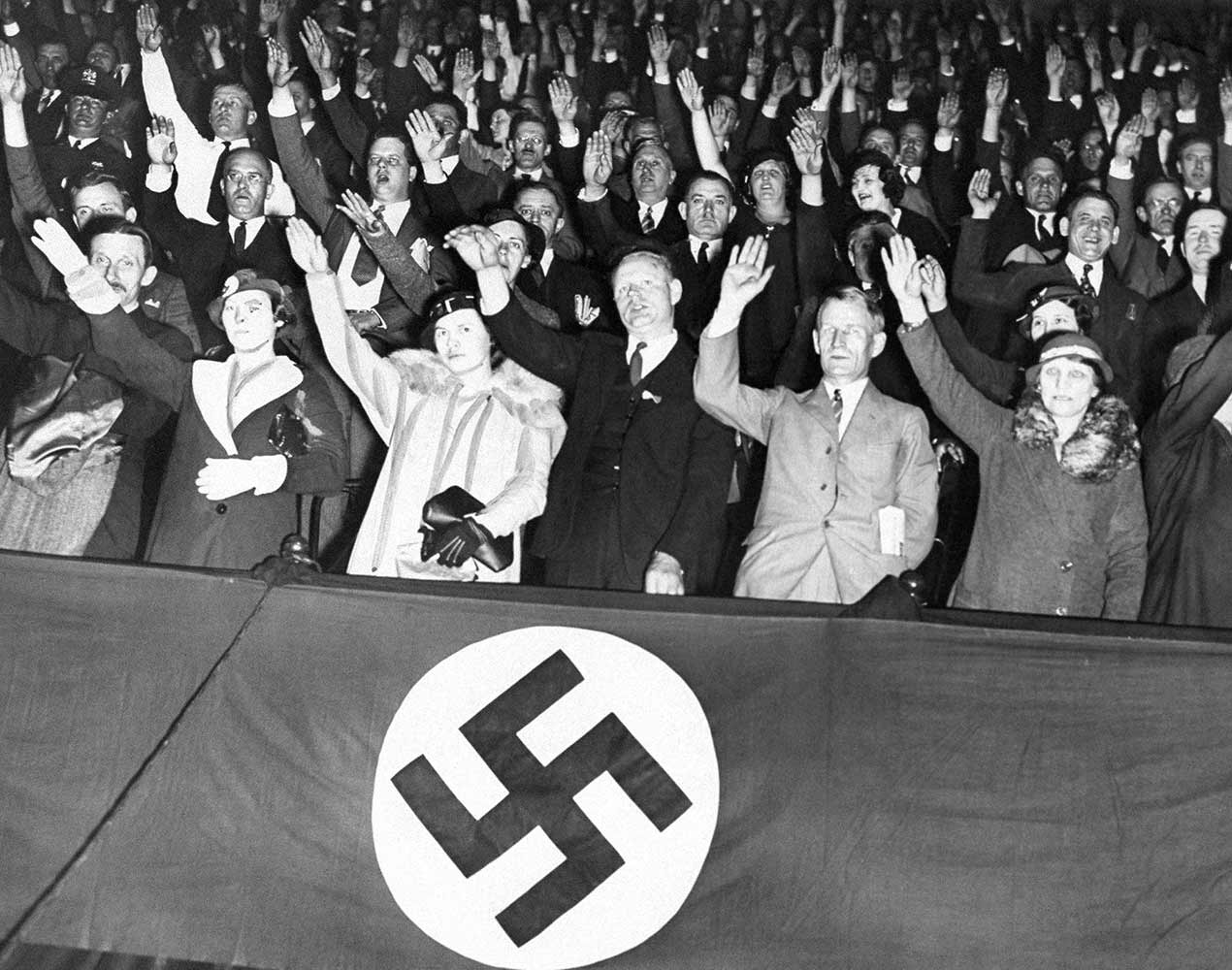What Is the History of Fascism in the United States?
In Fascism Comes to America, Bruce Kuklick traces the shifting meanings of the term “fascist” from its origins to the present day and how it has, over the years, gradually lost its coherence.

The term “fascism,” as we know it, originates in the Latin fasces, the name for the bundle of rods, with an ax projecting from the middle, carried by an official known as the lictor in ancient Rome as a symbol of the magistrate’s authority. More than just a symbol, the rods were also intended for these officials to beat back unruly crowds and administer corporal punishment; the ax advertised the threat of execution for those who committed especially severe offenses. The reverse side of Roman imperial coins featured a lictor with his rods, all the way up to the time of the fall of Constantinople in 1453. The intimidatory intent was there for all to see.
By the 18th century, however, the fasces—without the ax—had also come to symbolize the strength of unity: Bound in a tight bundle, after all, rods are hard to break. The founding fathers of the United States chose the symbol to adorn the Capitol building. The Lincoln Memorial in Washington, D.C., showed its dedicatee resting his hands on arm rests made from fasces. By this time (1922), fasces had also been given a new though not unrelated political meaning by the Italian journalist and politician Benito Mussolini, who called the members of his movement Fascisti. In his “Fascist” movement, authority was enforced through violence, underpinned by the idea of a group of political activists—eventually, indeed, an entire nation—tied together in a bundle so tight that it couldn’t be separated.
At the center of Italian fascism sat these two ideas: a cult of violence involving the worship of authority, on the one hand, and a desire to bind the disaggregated individuals of modern society into a tight-knit and orderly organization, on the other. To realize this twin vision, Mussolini’s blackshirts formed paramilitary squads to beat up, intimidate, and sometimes kill their opponents and drive them from the streets. In 1922, Mussolini was appointed prime minister of Italy after a series of violent takeovers of cities and a threatened march on Rome. He soon set about destroying democracy and creating a dictatorship, achieving most of his aims by 1930.
From the very beginning, Italian fascism was a militaristic movement, glorifying war and armed conflict. Despite its destruction of democratic institutions, its establishment of a one-party state, its suppression of civil liberties, and its cruel and sometimes murderous treatment of its opponents, however, Italian fascism attracted many admirers across Europe and the world. Even Charlie Chaplin, whose 1940 movie The Great Dictator included a satirical depiction of Mussolini, found time in 1931 to praise him for making the Italian trains run on time.
In the United States, small groups sprang up across the country describing themselves as fascist. Marching side by side in identical uniforms, they came to be identified by the color of their shirts. In 1934, the American Civil Liberties Union even commissioned a pamphlet titled “Shirts! A Survey of the New ‘Shirt’ Organizations in the United States Seeking a Fascist Dictatorship,” which parsed the different organizations: the Gold Shirts, Silver Shirts, Brown Shirts, Black Shirts, Gray Shirts, White Shirts, and Blue Shirts. P.G. Wodehouse mocked the phenomenon in his classic comic novel The Code of the Woosters, in which the bullying would-be dictator Sir Roderick Spode calls his paramilitaries “the black shorts” “because there were no shirts left,” as one of the characters explains.
Americans tended to find both Mussolini and the tiny groups who imitated him in the United States difficult to take seriously. As Bruce Kuklick observes in his recent study of the concept of fascism in the United States, this was true of Hollywood too. Its movies tended to portray Italian fascists “as pathetic fools, never as a primary enemy.” With the Nazi seizure of power in Germany in 1933, however, the various colored-shirt organizations of fascists in America and elsewhere no longer appeared to be so much of a joke. The repulsive and murderous violence Hitler unleashed on the streets; the public book burnings carried out by students in university towns across Germany on May 10, 1933; the incarceration of almost 200,000 opponents of the Nazis in concentration camps within the first few months of the “Third Reich”; the discriminatory measures against Germany’s Jewish citizens introduced within a few weeks of the formation of Hitler’s government—all this and much more made a far stronger and more sinister impression on Americans than Mussolini’s histrionics had managed to do. Fascism was now something also to be feared.
In Fascism Comes to America, Bruce Kuklick traces the shifting uses of the term “fascist” in the United States from its origins to the present day. Over the years, he argues, the concept gradually lost its coherence. The conceptual inflation of the term had already begun in the 1930s, with the political journalist Dorothy Thompson declaring, “I happen to dislike intensely ‘liberal’ fascists, reactionary fascists, labor fascists, industrial fascists, Jewish fascists, Catholic fascists and personal fascists.” She thought Roosevelt’s New Deal was fascist and worried that the swastika might become a “symbol of the whole of Western civilization.”
Yet until the postwar era, the relative coherence of the idea of fascism somehow managed to survive this conceptual muddling and retain its power to denote far-right, racist, and militaristic dictatorships. Through the 1950s and ’60s, even when, as was now commonly the case, “fascism” meant above all Nazism or something that shared many of its characteristics, antisemitism and the Holocaust only took a secondary role in its definition.
Kuklick illustrates his argument by including fictional depictions of fascism, both on the page and on the silver screen. Novels centering on what we would now call “fascism” appeared even before the arrival of fascism itself. In his 1908 The Iron Heel, Jack London spun out a counterfactual story in which the rise of a mass socialist party in the United States (itself a highly unlikely scenario) provoked the barons of industry to overthrow the Constitution and impose a dictatorship enforced by thousands of thuggish mercenaries. Similar events form the central theme of Sinclair Lewis’s 1935 It Can’t Happen Here, which was made into a movie. Indeed, it was in Hollywood that most depictions of fascism achieved their most dramatic expression, with movies such as Black Legion, released in 1937 and starring Humphrey Bogart, purveying an entirely negative view of a far-right paramilitary movement descending into criminality and violence.
The beginning of World War II led to the creation of even more movies with fascism as their subject. Many have had a lasting value, notably of course Michael Curtiz’s 1942 Casablanca. There were also some often bizarre anti-fascist offerings, such as Cowboy Commandos, a musical in which a cowboy sings “I’m gonna get der Führer sure as shootin’,” or (my favorite) The Hitler Gang, made in the style of a Hollywood gangster movie and featuring obscure look-alike actors playing Hitler, Goebbels, and other leading Nazis. (It was directed by John Farrow, the father of the Hollywood star Mia Farrow.) No fewer than 17 Superman shorts, Kuklick tells us, “had the man from Krypton tackling Nazis.” Disney played its part too, with “Donald Duck in Nazi-Land.” Meanwhile, however, Mussolini continued to feature as a figure of fun, nothing more than an impotent and posturing imitator of the German leader, in cartoons such as Disney’s “The Ducktators.”
After World War II, Kuklick notes, there was a shift in how fascism was talked about in the United States. Now, a new threat loomed in the American imagination—that of “totalitarianism,” a concept that emerged in the late 1940s with the coming of the Cold War, which equated Hitler’s regime in Germany and Stalin’s in the USSR. “Totalitarianism” was, in fact, another Italian term used by Mussolini to describe his own regime in a positive sense in the 1930s. But its meaning shifted during the war to become a catchall term for a political regime, rather than a movement, that combined the alleged characteristics of both fascism and communism. A clutch of influential books marked this shift in the late 1940s and early ’50s, including George Orwell’s Nineteen Eighty-Four, Hannah Arendt’s The Origins of Totalitarianism, and Zbigniew Breszinski and Carl J. Friedrich’s Totalitarian Dictatorship and Autocracy. These and other works fused the memory of Nazism and the war against it with the perceived threat, both internal and external, of communism and invited readers to think of both regimes as essentially the same. The principal thrust of the strident, conspiracy-theory anticommunism of Senator Joseph McCarthy in the early 1950s would not have been so effective without this shift in how commentators conceived of fascism.
In the 1960s and ’70s, as McCarthy’s influence faded, “fascism” made a comeback. With the emergence of opposition to the Vietnam War, when liberal and leftist Americans began to campaign against the Johnson and Nixon administrations’ long military campaign against the North Vietnamese communists—exploiting the draft to send thousands of young men to die in a cause many of them did not support—the term reemerged to push “totalitarianism” into the background as radical opponents of the Vietnam War and the Cold War policies of that era began to use the concept to describe those politicians who supported them.
Popular
“swipe left below to view more authors”Swipe →Stanley Kubrick’s movie Dr. Strangelove, or How I Learned to Stop Worrying and Love the Bomb was one example of this view. Released in 1964 and depicting the run-up to a global thermonuclear war launched by the United States, the film features a German who has difficulty preventing his right arm from shooting up stiffly in a Nazi salute, even though he is the chief adviser to a liberal American president committed to fighting the Cold War. But it pointed to an underlying tension in US Cold War policy: While the government of the United States claimed to be fighting totalitarian regimes on the left, it was more than happy to partner with those situated on the right.
Conservatives also began to apply the term “fascist” to their opponents on the left: Alan Dershowitz, for example, denounced the “radical feminists” who wanted to ban pornography and declared that “feminist fascists are no better than any other kinds of fascist.” The fall of communism in 1989–90 opened the floodgates to an increasingly indiscriminate use of the term “fascist.” As Kuklick notes: “In the last decades of the twentieth century and into the twenty-first,” fascism became “a multipurpose negative word with which people of one political breed could brand another.” “Fascism” soon lost whatever relative clarity it had retained and “became a dizzying word of disapprobation, applied to anyone, anywhere.”
Kuklick acknowledges that ever since it became a political identity, fascist has existed in the United States—including, he notes, the many German scientists, technicians, and “doubtful bureaucrats” who had worked for Hitler’s Germany and then came to work for the United States—but ultimately he concludes that fascism as a political and social movement has always been above all a European phenomenon, the ultimate product of World War I’s unbridled violence and hatred, with merely echoes in other parts of the world.
In Kuklick’s view, this remains the case when it comes to the ongoing debate over fascism in the United States today. Since Donald Trump’s election to the presidency in 2016, “analogies to the 1930s” have become “a growth industry,” Kuklick notes. Discussion of whether Trump was a fascist, or even a reworked version of Hitler, suddenly pervaded the pages of the weekly and monthly magazines. Alarmed scholars started dispensing advice on how to avoid the rebirth of fascism and protect democratic institutions from destruction. Yet, Kuklick argues persuasively, there are key differences between Hitler and Trump. In foreign policy, Trump is an isolationist, not an imperialist pursuing foreign aggression like Hitler. Far from being a Nazi-style militarist, he has pursued the withdrawal of the US military from foreign adventures. “At home, his policies often sponsored federalism, local options versus the national,” in sharp contrast to Hitler and Mussolini, who centralized everything and stripped local and regional administrations of their autonomy. One might add that while Trump shared with “real fascists” a contempt for democracy and its institutions and a willingness to use violence to try to overthrow the Constitution, his followers in the January 6, 2021, storming of the Capitol were a jumble of assertively individualistic rebels, about as far as one could get from the serried ranks of uniformed and disciplined brownshirts goose-stepping their way through the streets of Berlin in the 1930s.
Perhaps unfortunately, Kuklick’s fascinating and thought-provoking study ends at this point. This is one of those rare books one wishes had been longer. He demonstrates successfully how the concept of fascism has changed its meaning and its place in American political discourse over the past century and more, providing entertaining quotes and examples along the way. Despite his frustration with the conceptual expansion and devaluation of the term in the past few decades, he clearly believes that it still has some real meaning: His demonstration of the huge variety of political phenomena and practices to which the term “fascism” has been and continues to be applied “does not mean,” he says, “that fascism is devoid of meaning or that it is a vacuous signifier.” The debate will continue, and it is to be hoped that the author gets the opportunity to expand his account sometime in the not too distant future, especially if Donald Trump wins the next US presidential election, as seems a distinct possibility at the time of writing.
More from The Nation

No, Kamala Harris Staffers Did Not Run a “Flawless” Campaign No, Kamala Harris Staffers Did Not Run a “Flawless” Campaign
Democratic strategists are still patting themselves on the back for a catastrophic defeat.

Human Rights for Everyone Human Rights for Everyone
December 10 is Human Rights Day, commemorating the anniversary of the Universal Declaration of Human Rights (UDHR), one of the world's most groundbreaking global pledges.

The Courts, Trump, and Us: A Q&A With David Cole The Courts, Trump, and Us: A Q&A With David Cole
Last time, the courts were an essential checking force on the Trump administration. This time around, they may again provide a check—if we push.

Can You Understand Ireland Through One Family’s Terrible Secret? Can You Understand Ireland Through One Family’s Terrible Secret?
In Missing Persons, Clair Wills's intimate story of institutionalized Irish women and children, shows how a family's history and a nation’s history run in parallel.

The Underground Network Helping Gazan Refugees Survive in Egypt The Underground Network Helping Gazan Refugees Survive in Egypt
A patchwork of volunteer-run mutual aid organizations has sprung up to tackle the severe problems facing people fleeing genocide.

Why Bidenomics Was Such a Bust Why Bidenomics Was Such a Bust
A large majority of voters gave the Biden administration a failing grade on the economy. For the sake of future policy battles, it is worthwhile to try to understand their reasons...


